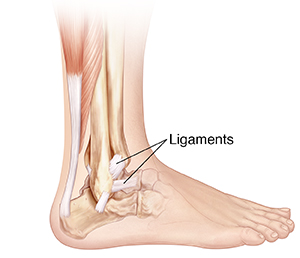Understanding Ankle Sprain
The ankle is the joint where the leg and foot meet. Bones are held in place by connective tissue called ligaments. When ankle ligaments are stretched to the point of pain and injury, it's called an ankle sprain. A sprain can tear the ligaments. These tears can be very small but still cause pain. Ankle sprains are graded by the amount of ligament damage.
-
Grade 1 (mild). There is slight stretching and tiny tears to the ligament fibers. You may have mild ankle pain, swelling, and tenderness.
-
Grade 2 (moderate). This is a partial ligament tear and causes moderate ankle pain, swelling, tenderness, and bruising. There may be abnormal looseness when the healthcare provider moves your joint.
-
Grade 3 (severe). There is a complete tear to the ligament and a great deal of ankle pain, swelling, tenderness, and bruising. The ankle joint may be very unstable.

What causes an ankle sprain?
A sprain may occur when you twist your ankle or bend it too far. This can happen when you stumble or fall. Things that can make an ankle sprain more likely include:
-
Having had an ankle sprain before
-
Playing sports that involve running and jumping. Or playing contact sports such as football or hockey.
-
Wearing shoes that don’t support your feet and ankles well
-
Having ankles with poor strength and flexibility
Symptoms of an ankle sprain
Symptoms may include:
-
Pain or soreness in the ankle
-
Swelling
-
Redness or bruising
-
Not being able to walk or put weight on the affected foot
-
Reduced range of motion in the ankle
-
A popping or tearing feeling at the time the sprain occurs
-
An abnormal or dislocated look to the ankle
-
Instability or too much range of motion in the ankle
Treatment for an ankle sprain
Treatment focuses on reducing pain and swelling, and preventing further injury. Treatments may include:
-
Resting the ankle. Don't put weight on it. This may mean using crutches until the sprain heals.
-
Prescription or over-the-counter medicines. These help reduce swelling and pain.
-
Cold packs. These help reduce pain and swelling.
-
Raising your ankle above your heart. This helps reduce swelling.
-
Wrapping the ankle with an elastic bandage or ankle brace. This helps reduce swelling and gives some support to the ankle. In rare cases, you may need a cast or boot.
-
Stretching and other exercises. These improve flexibility and strength.
-
Heat packs. These may be advised before doing ankle exercises.
-
Surgery. Surgery for ankle sprain is rare. But it may be advised for sprains that don't heal with nonsurgical treatment. Or for lasting ankle instability after rehab and nonsurgical treatment.
Possible complications of an ankle sprain
An ankle that's been weakened by a sprain can be more likely to have repeated sprains afterward. Doing exercises to strengthen your ankle and improve balance can reduce your risk for repeated sprains. Other possible complications are long-term (chronic) pain or an ankle that remains unstable.
When to call your healthcare provider
Call your healthcare provider right away if you have any of these:
-
Fever of 100.4°F (38°C) or higher, or as advised by your provider
-
Chills
-
Pain, numbness, discoloration, or coldness in the foot or toes
-
Pain that gets worse
-
Symptoms that don’t get better, or get worse
-
New symptoms
© 2000-2024 The StayWell Company, LLC. All rights reserved. This information is not intended as a substitute for professional medical care. Always follow your healthcare professional's instructions.